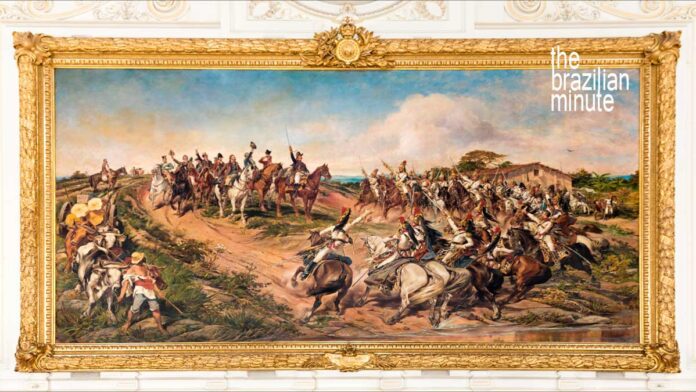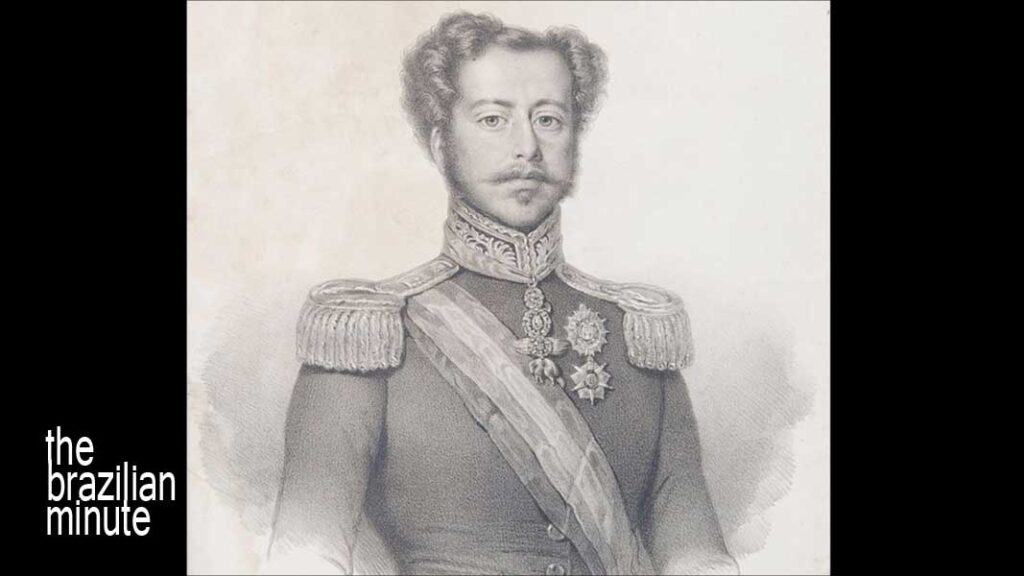
2022’s Bicentennial Year Is A Once-In-A-Lifetime event For Brazilians Worldwide
Brazil’s Independence Day explained. Explore Brazil’s path to independence and its first 200 years as a nation.
This series was presented by the Consulate-General of Brazil in Chicago and the Brazilian Foreign Ministry’s Cultural Department.
In celebration of Brazil’s Bicentennial year, 1822 – 2022
This week’s Brazilian Minute: Brazil’s Independence Day Explained
(Audio not available)
Catch up with other Brazilian Minute episodes you may have missed!
Script from Audio:
At the center of a public park in São Paulo stands a statue celebrating the moment of Brazil’s Independence from Portugal. The date, as every Brazilian from school age on will tell you, is September 7, 1822.
It began with the Napoleonic War when the Portuguese Empire moved to the safety of Rio de Janeiro in 1808.
The Royal Family returned to Lisbon after Waterloo, leaving behind their son Pedro as Prince Regent.
But demands on Brazil to fund the Empire’s debt eventually led Dom Pedro to São Paulo, to proclaim, “Independence or Death,” and the nation of Brazil was born.
Brazil’s cultural contributions to the world through arts, the humanities, science, and diplomacy are a testament to its 200-year history, its people, and its future.
Read and listen to new weekly episodes of The Brazilian Minute.

More on: Brazil’s Independence Day Explained
Overview:
2022 is Brazil’s Bicentennial year. Its first 200 years as an independent nation are on full display to the world and importantly, for Brazilians everywhere.
Especially on the days and weeks surrounding Brazil’s observation of its Independence Day, September 7th, 1822.
Brazil’s story of independence is as interesting as it is unique. Use the links provided for more information.
Brazil’s Independence Began With Discovery
Brazil was discovered on April 22, 1500, and the colony became an economic boon to the Portuguese Empire. Portugal competed with Spain, France, England, and the Dutch as world powers.
The land’s vast resources were exported to Lisbon and then sold throughout Europe and beyond.
Interestingly, one of the colony’s first exports actually gave the land its name.
The dye from the native Pau Brasil (Brazilwood tree) yields a deep red color. In high demand for luxury textiles, it was less expensive to produce than the Caesalpinia trees found in Asia. Other crops for export followed, including cotton, sugar, and later, coffee.
Napoleon’s Role In Brazil’s Independence
Ironically, it was France, not Portugal which planted the seeds of nationhood for Brazil.
Napoleon invaded Iberia in 1807. Less than a year later, Portugal’s Royal Court relocated the seat of the Empire to Rio de Janeiro. This is the first (and only) time that a European Capital would exist outside of Europe.
With the Royal Family came the amenities of the ruling class. High fashion, cuisine, technology, and culture transformed Rio de Janeiro to bring a singular identity to all of Brazil.
Napoleon’s defeat came at a great cost to the Empire. Ultimately causing the Royal Family to return to Lisbon in 1821. They left their young son, Pedro to rule over the colony as Prince Regent. Quickly, a battle of wills arose between Pedro’s Brazilian court and Portugal’s advisors.
Brazil’s Final Steps To Independence
However, Dom Pedro was soon convinced to choose a pathway to independence. Subsequently, on January 9, 1822, he formally announced his refusal to return to Lisbon. This celebrated day in Brazilian history is known as Dia do Fico.
Seven months later on September 7, 1822, Dom Pedro proclaimed independence near the Ipiranga river in São Paulo. But not everyone agreed. It took decades to resolve these conflicts and disputes, but independence and freedom led to the way forward.
The Golden Law
This included one of the most important pieces of legislation in Brazilian history, the Lei Áurea, the Golden Law. Signed by Brazil’s Princess Isabel on May 13, 1888, this law abolished slavery in Brazil. Learn more about both the African and Indigenous cultures of Brazil.
The Lei Áurea is simply stated and direct, taking a total of 18 words to define itself.
That’s the exact length of the previous sentence.
The Proclamation of the Republic came on November 15, 1889, to formally introduce the Republic of the United States of Brazil to the world.
Let’s Celebrate Brazil’s Independence Day
Brazil’s Independence Day is celebrated with parades and cultural performances, and firework displays in cities across Brazil.
In São Paulo, the Ipiranga Museum (Paulista Museum) in Independence Park has reopened after a decade-long restoration. On display are more than 3,000 historical artifacts, including paintings, documents, personal items, and memorabilia.
The most popular room in the Ipiranga Museum features the historic painting by Pedro Américo. This national treasure depicts the movement of Brazil’s cry for independence. It was presented by the artist in 1888, a year ahead of Brazil’s Proclamation of the Republic. You’ll see its image at the top of this page.
Also included, is a house atop a nearby hill, marking the location where Dom Pedro raised his sword to shout “Independence or Death” in 1822.
The Government’s celebration is held on the Ministries Esplanade in the capital of Brasilia with the president of Brazil leading the nation’s official parade.
Celebrating Brazil’s Independence Day Worldwide
In honor of its Bicentennial, Brazil has planned a series of activities to celebrate the country’s progress over its first 200 years. The motto “Freedom, Independence, and Sovereignty” guides the events.
Brazilian Embassies, consulates, and missions are advancing a multitude of cultural and community activities worldwide.
For Brazilians, these Bicentennial celebrations are a once-in-a-lifetime opportunity to reflect on the spirit of their nation with personal pride. At home or throughout the world, the people of Brazil are brave, welcoming, strong, and passionate about their homeland.
September 7th is also a time to celebrate Brazil’s abiding friendship with the United States.
The American Revolution inspired the ideas of freedom and sovereignty in Brazil. The United States was the first country to recognize Brazilian independence.
From the beginning, this partnership of freedom and independence between Brazil and the USA continue to grow stronger. Both Brazil and the United States of America represent two of the largest economies and democracies in the Western Hemisphere.
Music, Travel, Friends, and Fun! 2022 marks Connect Brazil’s 25th year.
Brazil’s Independence Day Explained
Did you enjoy ’Brazil’s Independence Day Explained’? If you did, why not join us at Connect Brazil?
Sign up for our emails on Brazilian music, travel, friends, and fun. Listen to our ‘always live’ streaming station and streaming music channels, always free. Visit us on Facebook, and Twitter, and browse our Lifestyle Directory for Brazilian events coast to coast.










